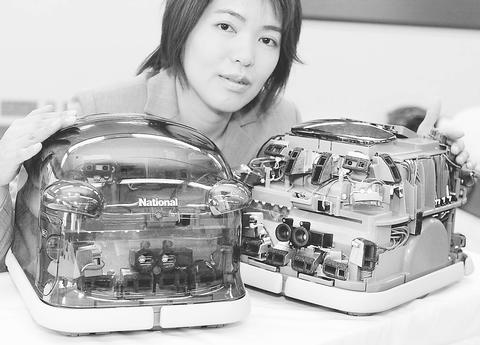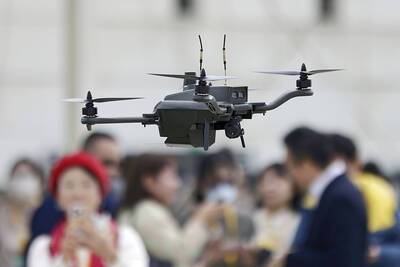The vacuum-cleaning robot from Japanese electronics manufacturer Matsushita Electric Industrial Co still crashes into chair legs and leaves lots of corners unswept.
But the unnamed test model, shown to reporters yesterday, is set to go on sale in three years with a price tag of Japanese yen 500,000 (US$3,800), the Osaka-based company said.
That's a target price counting on technological developments over the next few years that should bring down costs, officials said. The cordless machine, slightly bigger than a basketball, required Japanese yen 200 million (US$1.5 million) of research costs.

PHOTO: AFP
The company, which makes the Panasonic brand, has no export plans for the robot.
Matsushita said its autonomous-control technology can be used in other housekeeping robots that can work as a security guard or a caretaker for children or the elderly when equipped with features like cameras and mobile connections.
Eye-like lights glowing in the front and the back, the vacuuming robot comes with 50 sonic, infrared and other types of sensors so it turns before running into walls and avoids falling off steps.
Running for 55 minutes on a single battery charge, it figures out the size of a room by circling around it once and then travels horizontally and vertically to crisscross through the room to vacuum 92 percent of the floor space, Matsushita said.
It can't clean the edges because it's designed to stop 15cm before a wall and other obstacles that are at least 3cm wide.
"We have long been tackling the automation of domestic chores," said Matsushita director Yoshitaka Hayashi. "Robots will someday guard against fires and burglary in homes while people are asleep."
In a demonstration at Matsushita's Tokyo office, the vacuuming robot inched around a set similar to a living room, avoiding cabinets and furniture but left large portions near walls untouched. A person would have to use a regular vacuum cleaner to do a more thorough job, Matsushita said.
The robot took about nine minutes to finish the task, but officials acknowledged a person could do it in about five minutes. The robot also needs more work because it can get stuck under chairs and tables, they said.
The robot is designed to suck things up more powerfully and slow down when traveling over dusty areas.
Several of the robots will be tested in Japanese homes starting in May.
A number of Japanese companies are selling and developing robots for homes, although the offerings from Sony Corp, for example, are strictly for entertainment. Matsushita has developed vacuuming robots for industrial use, but they weren't designed to dodge obstacles.
Japan leads the world in robot use, a nation that accounts for nearly half of the new robots installed worldwide in 2000, according to the UN.

The combined effect of the monsoon, the outer rim of Typhoon Fengshen and a low-pressure system is expected to bring significant rainfall this week to various parts of the nation, the Central Weather Administration (CWA) said. The heaviest rain is expected to occur today and tomorrow, with torrential rain expected in Keelung’s north coast, Yilan and the mountainous regions of Taipei and New Taipei City, the CWA said. Rivers could rise rapidly, and residents should stay away from riverbanks and avoid going to the mountains or engaging in water activities, it said. Scattered showers are expected today in central and

COOPERATION: Taiwan is aligning closely with US strategic objectives on various matters, including China’s rare earths restrictions, the Ministry of Foreign Affairs said Taiwan could deal with China’s tightened export controls on rare earth metals by turning to “urban mining,” a researcher said yesterday. Rare earth metals, which are used in semiconductors and other electronic components, could be recovered from industrial or electronic waste to reduce reliance on imports, National Cheng Kung University Department of Resources Engineering professor Lee Cheng-han (李政翰) said. Despite their name, rare earth elements are not actually rare — their abundance in the Earth’s crust is relatively high, but they are dispersed, making extraction and refining energy-intensive and environmentally damaging, he said, adding that many countries have opted to

SUPPLY CHAIN: Taiwan’s advantages in the drone industry include rapid production capacity that is independent of Chinese-made parts, the economic ministry said The Executive Yuan yesterday approved plans to invest NT$44.2 billion (US$1.44 billion) into domestic production of uncrewed aerial vehicles over the next six years, bringing Taiwan’s output value to more than NT$40 billion by 2030 and making the nation Asia’s democratic hub for the drone supply chain. The proposed budget has NT$33.8 billion in new allocations and NT$10.43 billion in existing funds, the Ministry of Economic Affairs said. Under the new development program, the public sector would purchase nearly 100,000 drones, of which 50,898 would be for civil and government use, while 48,750 would be for national defense, it said. The Ministry of

UNITED: The other candidates congratulated Cheng on her win, saying they hoped the new chair could bring the party to victory in the elections next year and in 2028 Former Chinese Nationalist Party (KMT) lawmaker Cheng Li-wun (鄭麗文) yesterday won the party’s chair election with 65,122 votes, or 50.15 percent of the votes. It was the first time Cheng, 55, ran for the top KMT post, and she is the second woman to hold the post of chair, following Hung Hsiu-chu (洪秀柱), who served from 2016 to 2017. Cheng is to succeed incumbent Eric Chu (朱立倫) on Nov. 1 for a four-year term. Cheng said she has spoken with the other five candidates and pledged to maintain party unity, adding that the party would aim to win the elections next year and